Pharm Exec's 14th Annual Industry Audit
After a sharp spike in revenues, this year’s audit finds our 25 companies doubling down to secure the operational efficiencies that promise to better align with an increasingly tightfisted payer community. Never before has market relevance been so firmly linked to customer reputation.
The Big Glare: Pharma in the Spotlight
If it was any other year, Pharm Exec’s 2014 Industry Audit results would be considered as a standout, stellar performance. But coming just on the heels of the industry’s spectacular revenue run up in 2013-2012, this year’s rendition of the audit dims a bit in comparison. However, in a global business environment marked by collaborative, cross-sector relationships, it is important to emphasize that biopharmaceuticals continue to lead other industries by outpacing the overall growth in the US economy. This is despite some headwinds that are fairly specific to the biopharma business, including a significant regulatory burden; growing payment pressures, particularly from the public-sector side; and, for US-based companies, the impact of a strong dollar on foreign-sourced earnings.
Now in its 14th year, the Pharm Exec Industry Audit holds a unique position in the increasingly crowded field of data sets evaluating industry performance. Since its debut in 2002, the audit adheres to a simple objective: to identify how well companies are doing in advancing shareholder value. Do they create it-or destroy it? The goal of the audit is to rank this performance for the top 25 publicly traded companies by sales revenues, on the basis of 10 metrics. Most, but not all, of these metrics are financial.
Shareholder value is admittedly a measure open to interpretation. There is no other standard accepted reference point that looks at performance from this perspective. But no one can argue that the approach is not relevant, given how shareholder value has emerged as a key rationale in driving M&A and licensing transactions to record levels this year.
Idiosyncratic or not, the audit also reveals the importance of broader, value-based measures that escape scrutiny by the major investor rating institutions. For example, an important metric in the audit is Return on Assets, a more targeted indication of operational excellence and efficiency than Net Profits. The audit also relies on a metric, Return on Invested Capital, which measures how well a company is managed, not on its stock value, a misleading indicator because it is susceptible to the feeding frenzy around activist trading.
In addition, our choice of metrics for the audit raises a provocative question: does the by-product of success-size and scale-limit in any way the capacity of management to be responsive to shareholders? Most of the “big” pharma companies on our list have tended to do less well in the rankings over time. While Pfizer and Merck scored at the top in our first several audits, their performance has never been repeated since. Our winners in recent years have been biotech and specialty contenders at the mid-range of the revenue curve. The scholarly business press has spent a lot of time examining this idea, using precedents like the faded glory of Procter & Gamble to consider whether successful companies eventually get too big to compete effectively.
The analogy to the biopharmaceutical sector is clear. Pfizer, Merck, Johnson & Johnson, GlaxoSmithKline, and Novartis spin out vast amounts of revenue but are still struggling to improve profitability and the growth in shareholder value that comes with it. Most of their product lines are just average in sales performance yet require lots of management attention as well as costly marketing investments that shrink the bottom line. For example, J&J had annual sales of $77.3 billion in 2014-2013, with a profit margin of 27.6%, a figure almost twice as high as the average for our list. But a closer look reveals that a still sizable chunk of J&J’s business is coming in at a lower rate than this 27.6%.
Consider the alternative. What if half of the underperforming strategic business units of J&J were able to raise profitability by just 1%, to 28.6%? Our calculations indicate this would result in almost $1 billion of additional pre-tax profit to J&J. Achieving the gain requires prices to be doubled or operating expenses to be halved; incremental, minor changes in the underachieving Strategic Business Units’ 30+ line items in the P&L statement and balance sheet, and then multiplying these through the balance sheet, will produce that 1% improvement in profitability.
On a broader plane, we see talk among investors about breaking up some of the key big pharma companies. On their own, these companies are pruning their assets back, as evidenced by the recent activity among GSK, Novartis, and Eli Lilly to swap therapeutic franchises, bolstering those areas where there is core competence. Pfizer management is formally committed to evaluating a split and is slated to make a decision on this as early as the end of next year. In the meantime, it plans to “invest to get smaller,” carefully choosing synergistic targets like its latest acquisition of Hospira, a leading contender in biosimilars.
Maybe the right question to ask is: might it be better, ultimately, to pursue a strategy around focus instead of scale? The audit’s top achieving biotechs, along with Shire, AstraZeneca, Bristol-Myers Squibb, Regeneron, and Vertex are unambiguously aligned around the focus model, pursuing new ground-breaking development pathways and narrow markets. Some would beg to differ, especially companies on our list in the generic and branded generic field, all of whom are in pursuit of increased scale. With the consolidation on the payer side, and merger frenzy as the top five insurers and managed care organizations dwindle down to three, Teva and Mylan are bulking up to maintain bargaining parity.
The dividing lines are set in what promises to be additional moves by our audit 25, as industry players adapt to an era of disruptive change, often coming from adjacent sectors who see ignorance of the traditional path to profits as a virtue-or, to put it more directly, a competitive advantage.
Methodology
This year’s audit evaluates 25 publicly traded drug firms. It relies on reported information posted during the 2013–2014 calendar period. It should be noted that the list of 25 companies is down from last year’s 27, as a consequence of extensive M&A activity. Forest and Allergan were both absorbed by Actavis, which has in turn been re-born as a much bigger company, adopting the Allergan name.
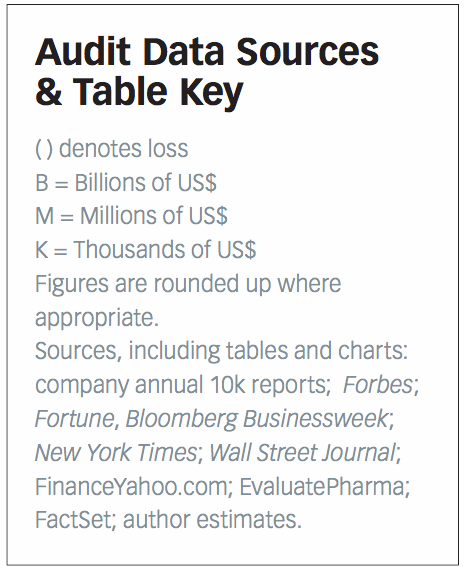
The audit also includes a new metric: Net Profit per Employee, which in our view is more informative than Sales per Employee. The metrics are also weighted, reflecting their relative importance in assessing a firm’s performance. Yes, some metrics are more important than others. The “Big 4” metrics are: growth in shareholder or enterprise value; ratio of enterprise value to sales; return on assets; and return on invested capital. The remaining metrics are: sales growth; gross margins; net profit to sales (EBITDA, or earnings before interest, taxes, depreciation and amortization); sales to assets (or asset turnover); and profit per employee.
A final, tenth metric-sales, general, and administrative expense (SG&A) to sales revenue-does not factor into the assessment of company performance. The reason is that in any one year, a company may be launching a new product or revising its marketing or branding strategy, and for that time period, SGA may sensibly need to increase. Over a longer time period, SG&A spend-really an indicator of overhead costs-should not outpace sales growth. If that happens, the firm can easily become associated with bloat and inefficiency. This makes SG&A worth tracking as an important bellwether of trouble ahead.
With the exception of this last metric, each metric is weighted, with the highest weight of three given to the “Big Four.” The other five metrics carry a weight of two. The higher a company performs on each metric, the better its overall performance. An overall rating of 25 is the top score, while a rating of one earns the bottom spot. For example, if a company places 22 out of the 25 on a key metric like Enterprise Value to Sales, it receives 66 points on that metric , as follows: rank 22 times a weight of three = 66 points. Conversely, if a firm comes in at a ranking of six, toward the bottom, on the metric Sales Growth with a weight of 2, its total points would be 12: a 6 ranking times two = 12 points. Company points on each metric are then added up to arrive at a total point score per company, from which the 25 firms are ranked to determine the audit’s top performer for the year.
In addition to the above nine weighted metrics, the audit includes a few “macro” benchmarks designed to capture external influences on companies. These include economic indicators like US GDP and Consumer Price Index (CPI), stock market tables like the Standard & Poor investor grade ratings and the Nasdaq and Dow Jones indices, as well as some specific investor growth metrics. While the exposure to these broad market forces is shared, companies often react -or are affected-differently. It is always useful to examine how individual firms compare to trends in the US economy, particularly on inflation and the rate of economic growth. Those that adjust well to such forces tend to have a leg up on competitors in the final ranking.
The ‘macro’ missive
Indeed, if a biopharmaceutical company can’t beat the underlying growth rate of the US economy and the US Consumer Price Index measuring inflation, then by definition it is in trouble. The analogy is even more relevant in the context of the two other key regional markets, Europe and Japan, where, despite a few isolated spikes, the overall economic data is even more sclerotic.
In the period 2013-2014, the US economy expanded about 2% while the rate
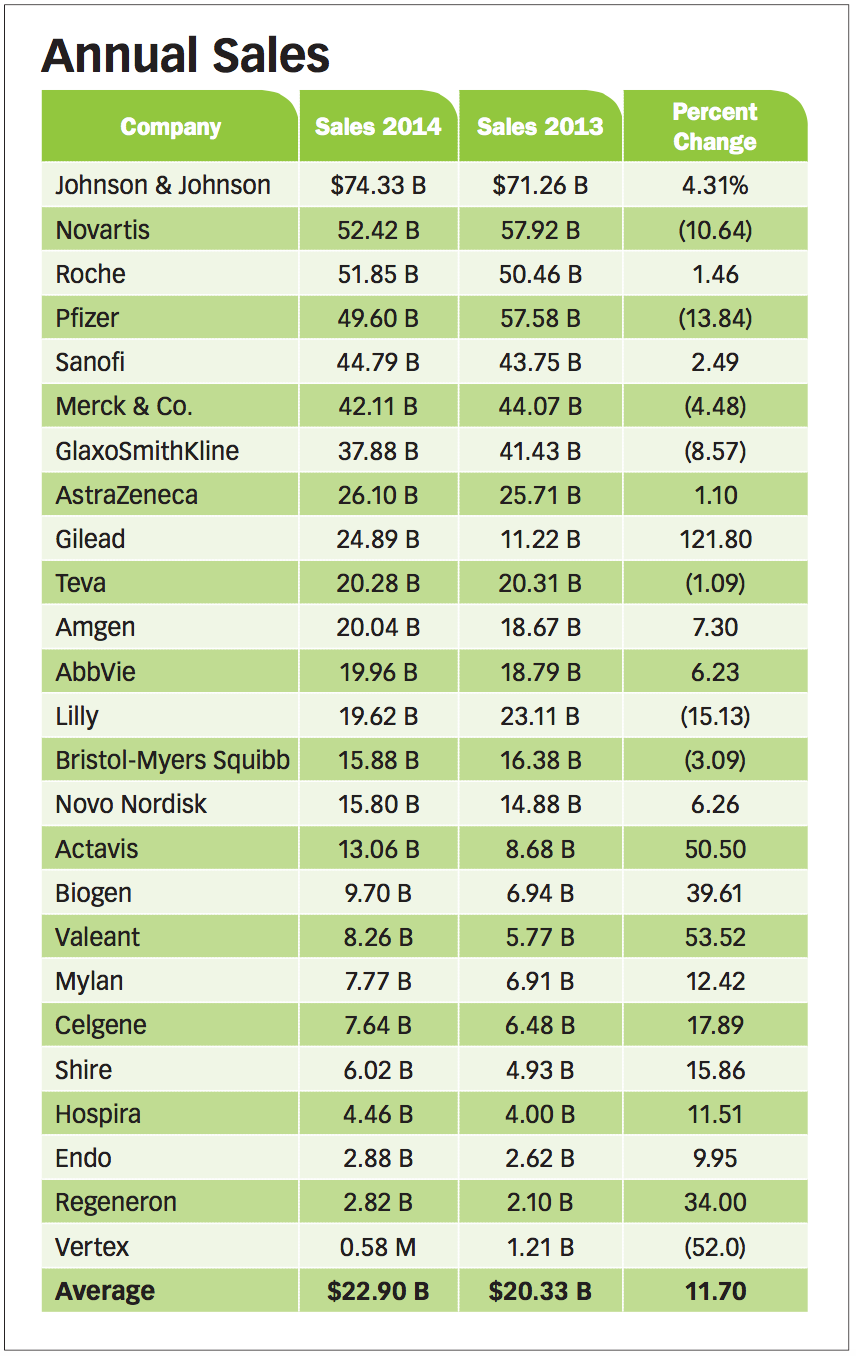
of inflation was less than 2%. In the Annual Sales table (right), we can see that our 25 companies substantially outpaced US economic growth, expanding at an average double-digit rate of 11.7% in sales versus. 5.3% for the prior year.
The performance was driven in part by a solid resurgence of spending on prescription drugs in the US. According to IMS, outlays on prescription drugs for 2013-2014 grew 13.1% at nominal prices, unadjusted for discounts and rebates. This compares favorably to an 8% increase in the Dow Jones industrial average and a 34% surge in the Nasdaq Biotech index. Revenue growth for the industry is likely to accelerate for the remainder of the decade, fueled by aging of the once-dominant baby boomer demographic. Estimates from the Congressional Budget Office (CBO) and other independent sources have spending on healthcare outpacing the rate of growth in GDP from now until the end of the decade and beyond.
Looking closer at the Annual Sales table, our “grow or you die” principle remains firmly in place. Sales performance for the group suggests that this principle might earn a second look within the “c suite.” The 11.7% average growth for the 25 companies is lower than the IMS estimate of a 13% increase in drug sales.
Most companies on the list grew at less than the average, with eight companies showing lower sales than for 2013. The standouts were Gilead Sciences, which benefited from the Sovaldi/Harvoni double-punch cure for hepatitis C virus (HCV), while Valeant and Actavis benefited from the momentum of their “growth by acquisition” strategy. In contrast, sales growth was off significantly for Vertex, due to fallout from its withdrawal of Incivek from the HCV space. Merck, Novartis, GSK and Lilly, each of whom has embarked on ambitious pipeline portfolio restructuring programs, suffered double-digit percentage slides in growth compared to 2013. This explains the interest of these big players in exchanging assets, to bolster those areas where therapeutic bench strength is already present and is, thus, most likely to provide a quick refresh to the revenue base.
Nevertheless, sales alone are not the determining factor for companies in delivering shareholder value. A good example comes from comparing WalMart to Amazon.com. The former, with its ubiquitous big box stores, might eclipse Amazon.com in total sales, but Amazon’s market capitalization, a truer reflection of investor sentiment, runs well past WalMart. Taking this analogy to our own industry, our list shows that Gilead ranks lower in 2014 annual sales than GSK, at $24.89 billion and $37.88 billion, respectively. But Gilead still posts a significantly higher number on shareholder value, at $158 billion, compared to $138 billion for GSK.
In this case, it’s the momentum that counts, as Gilead effectively doubled its sales in one year-so how could shareholders be disappointed? Another example of the underlying importance of growing sales was the negative reaction of Apple investors to a slump in second-quarter sales of the iPhone, which eclipsed the company’s banner performance in posting a record run-up in profits.
Enterprise value growth
The Enterprise Value, Percentage Growth table (below) consists of evaluating market capitalization (the number of common stock shares outstanding multiplied by the price of the stock on a given day) plus cash
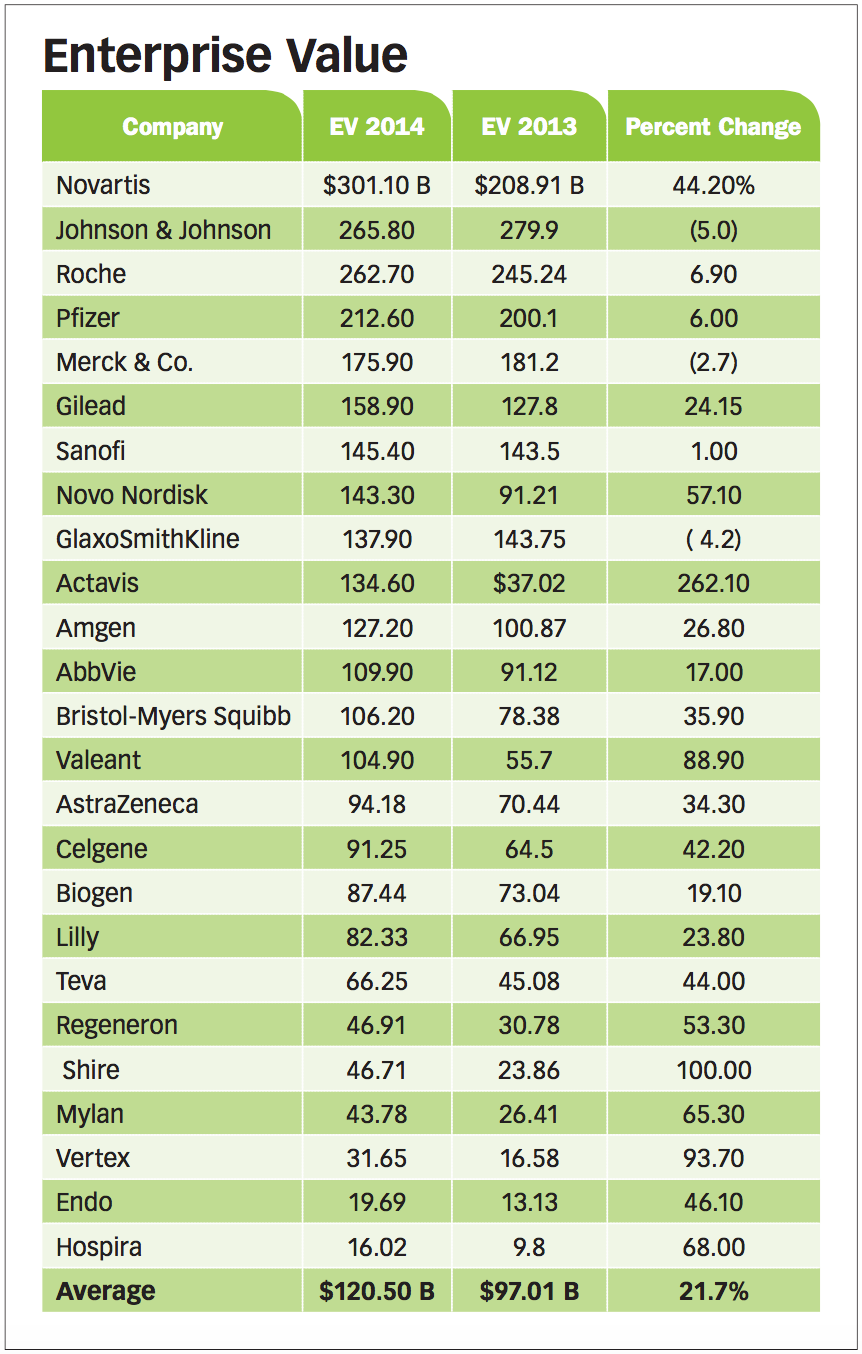
and cash-like liquid assets, minus debt and liabilities. The higher this ratio is, the higher the value of the company. The average percentage change in enterprise value growth in 2014-2013 for the 25 companies was 21.7%, compared to 62.7% in 2012-2011. Actavis, Valeant, Hospira, Mylan, Endo, and Teva had strong growth in enterprise value due mainly to the impact of M&A activity. Shire was also part of merger speculation, which impacted its high ranking as well.
Some of the acquisitions appear overpriced, with market capitalization to sales ratios of 11 times for Actavis’ acquisition of Allergan, Valeant’s 10 times ratio for its Salix Pharmaceuticals purchase, and the multiple of 29 that AbbVie’s negotiated for its purchase of Pharmacyclics. Reducing costs is often stated as the goal of these consolidations, but healthcare analyst Doug Sherlock tells Pharm Exec that only 15-20% of SG&A expenses are subject to economy-of-scale projections in the average merger in the life sciences.
Overall, Switzerland’s Novartis is presently the most valuable biopharmaceutical enterprise, with an enterprise value of $300.1 billion, according to FactSet. That’s an increase of over 44% compared to 2012-2011, a rise roughly double that of the average growth for the entire 25 companies.
Enterprise value to sales
Enterprise Value to Sales is a ratio that reflects the market’s assessment of future growth and profitability. The higher the ratio suggests that a firm’s best days are ahead; the lower the ratio implies the firm has hit a mature
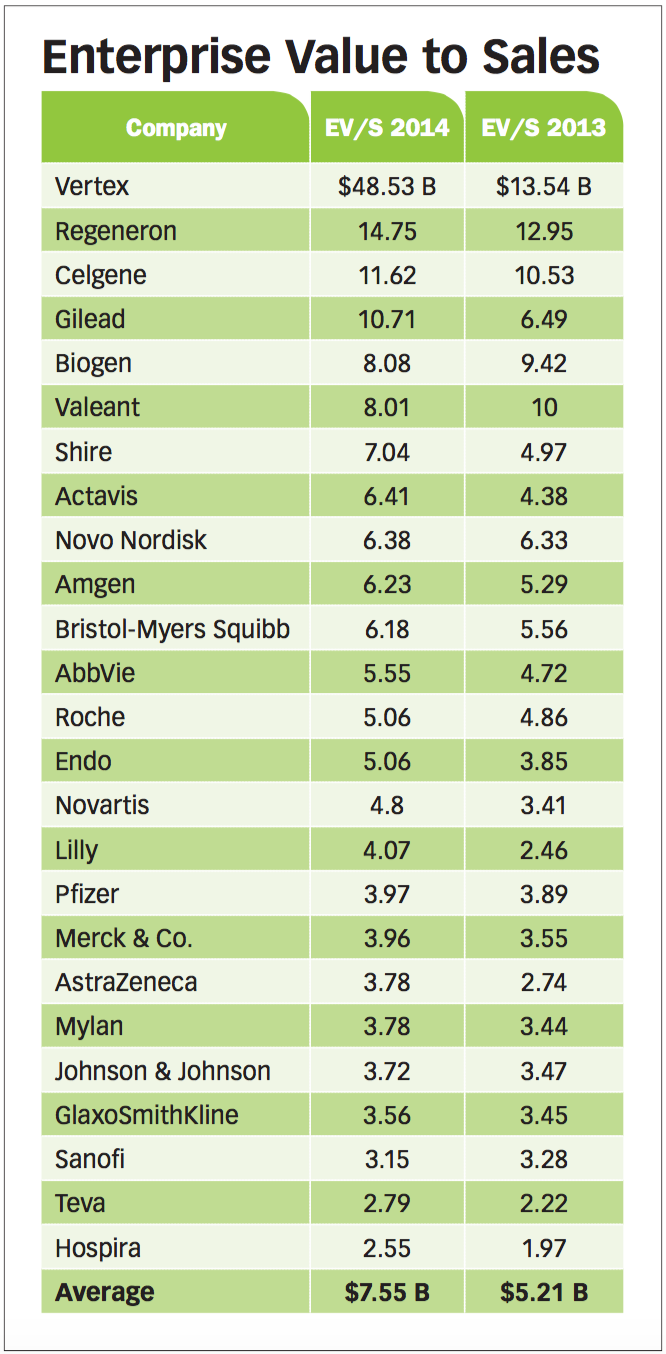
phase where growth and/or profitability have peaked. This year’s table (right) shows the average ratio at 7.55, compared to 5.21 for the period 2012-2011, indicating a relatively higher level of confidence in industry prospects, leveraged by a much more promising collective pipeline of new technologies and products. The top performer this year is Vertex, which has reemerged as an innovative force on the biologics front with Orkambi, a new, next-generation treatment for cystic fibrosis (CF), bolstered by the approval of new label indications for its flagship CF therapy, Kalydeco. Similar stories of positioning around leading edge science account for the runners-up on the high side of the enterprise value mountain, held by Regeneron, Celgene, Gilead, and Biogen, in that order.
Gross margin
Gross Margin is sales revenue minus cost of goods sold. This metric reflects a firm’s ability to price. The higher the gross margin, the more power a company has to raise prices. Demonstrating that capacity consistently, year

to year, is a mark of true distinction. Average Gross Margin for our 25 firms in 2014 was 68.80% compared to 68.13 percent in 2012-2011, a slight increase (see table). Needless to say, such numbers are substantially higher-in the nosebleed range-than the average in nearly all other industries. In spite of the reputation hit, it’s a nice problem to have.
The mega-investor Warren Buffet characterizes pricing power as “the moat surrounding and protecting your castle.” The ability to raise price and keep prices high is seen among the “Four Horsemen of the Apothecary:” Celgene (91.57%); Gilead (84.35%); Biogen (83.40%); and Novo Nordisk (83.00%). A less frothy example of pricing power is Valeant’s recent purchase of two nondescript generic drugs used by hospitals and its ability to leverage that acquisition by raising prices higher than costs by a substantial margin.
This suggests that, while having a dominant first-in-line position in an area of substantive new science certainly confers pricing power, a strong gross margin also depends on the skill in which management seizes opportunity in the field. There is not much difference in the margin performance of the diversified innovative producer Sanofi (59.6%) and Valeant (55.1%), the relentlessly opportunistic vendor of older, acquired small molecules.
Pre-tax profit margin to sales
Pre-Tax Profit Margin to Sales, or Net Income to Sales (below), is an indicator of profits-earnings before interest, taxes, depreciation, and amortization in relation to sales revenue. Net Profit is arrived at after subtracting operating expenses from Gross Margin. Net Profit to Sales is the
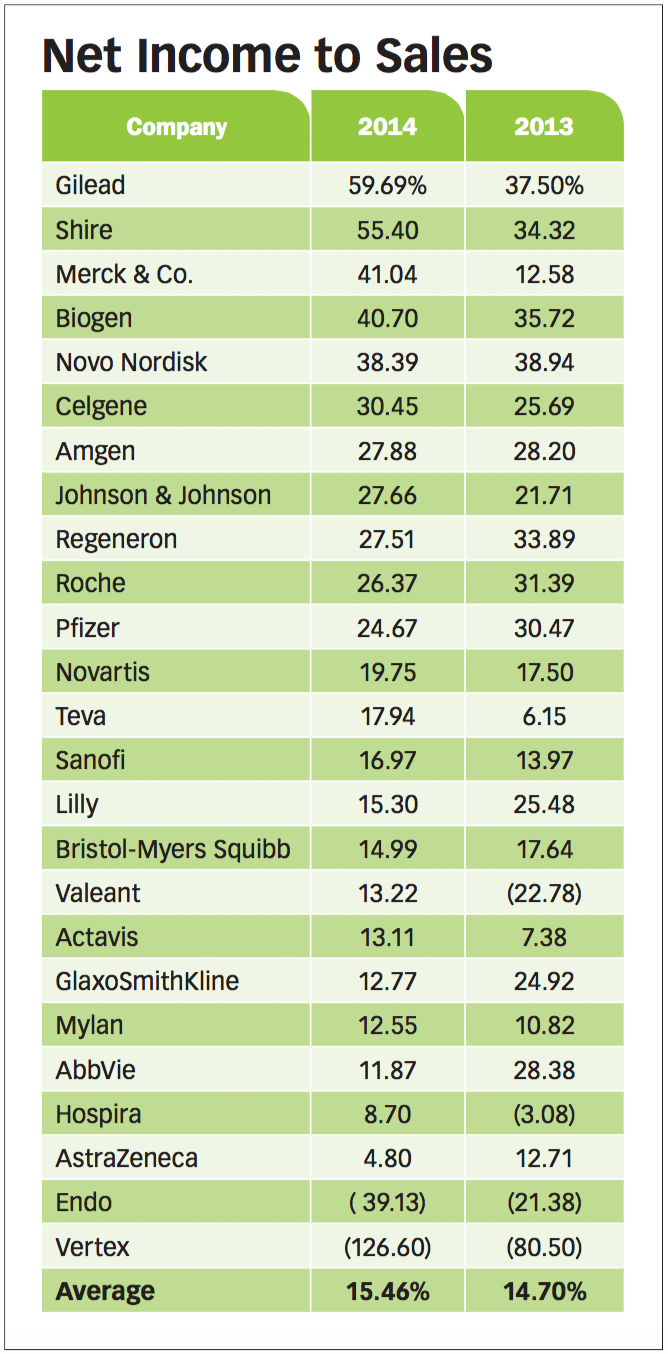
Profit Margin.
The profit margin measures how well the company deals with sales, price, cost of goods sold for ingredients used in manufacturing its products, operating expenses, and discounts, rebates, and royalties, if any. If you cannot grow revenues, then the appropriate management response is to get a better handle on operating expenses to bridge the divide. Merck is a good example of this: its sales decreased in 2014-2013 from 2012-2011 but its profitability increased significantly; Merck’s Gross Margin was held constant between the two years.
Even for a technology high-flyer like Google, becoming more disciplined in operating the business is having a positive impact on its valuation. Like our “Four Horsemen” biotechs, Google has never done a stock buyback nor paid dividends. But that is changing. One of the Horseman Four, Gilead, has announced it will do a stock buyback for the first time later this year.
It looks like it will be tight for Celgene to hit its goal of growing earnings by 23% a year through 2020. The same can be said for Novo Nordisk and its goal of hitting 15% growth in operating profit.
Sales to assets (asset management)
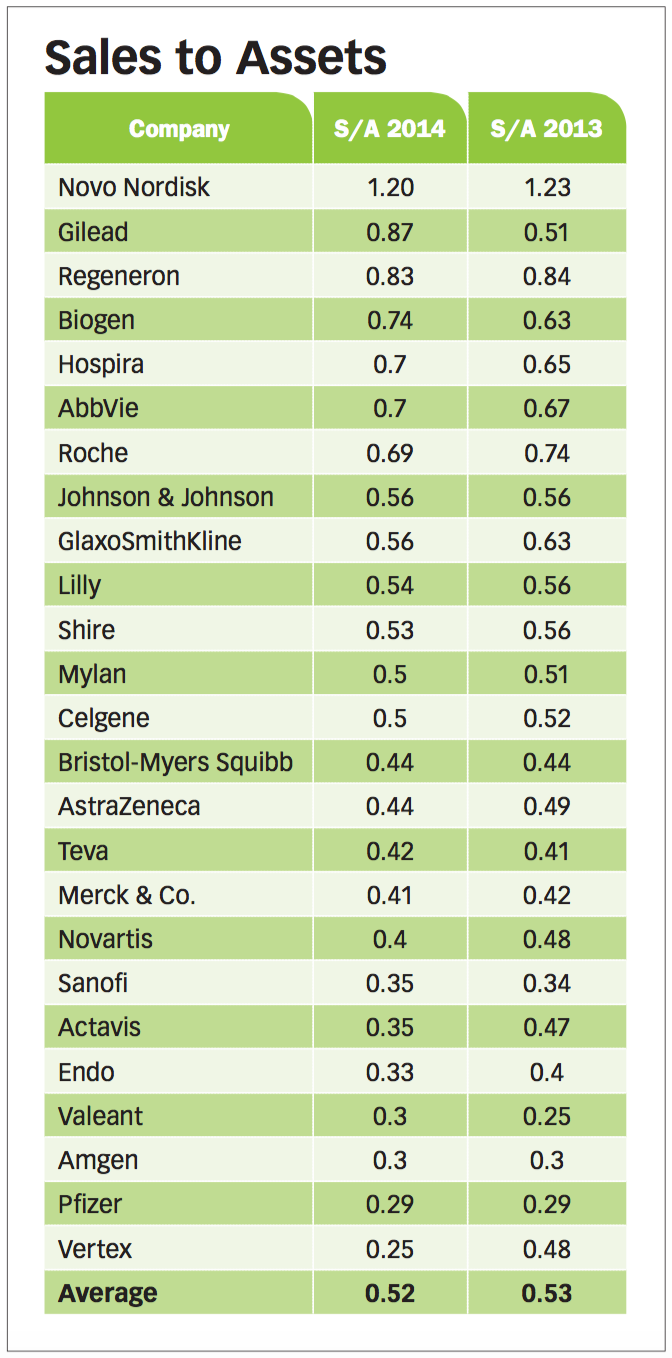
The Sales to Assets table (right) relays how well a firm handles managing its assets like cash, accounts receivable, property, equipment, and inventory. The ratio reflects what a firm gets back in return for every dollar invested in assets. At the top of the list, setting a high bar, is Novo Nordisk, with a Sales to Assets (S/A) ratio of 1.20; that is, for every dollar Novo Nordisk invests in assets, it generates $1.20 in return. The bottom position was occupied by Vertex, which scored 0.25, returning only a quarter in sales for every dollar it spent on an asset. The average S/A ratio for 2014 was 052.2, which Novo Nordisk more than doubled. The average ratio is down slightly compared to 2012-2011.
Return on assets
When you multiply Profit to Sales times Sales to Assets, you get Profit to Assets, which is a very important metric. Return on Assets (RoA) is much more informative than Profit Margin alone, because it measures excellence in management, that is, how good the firm is at not just controlling the profit margin, but in making efficient use of all its assets.
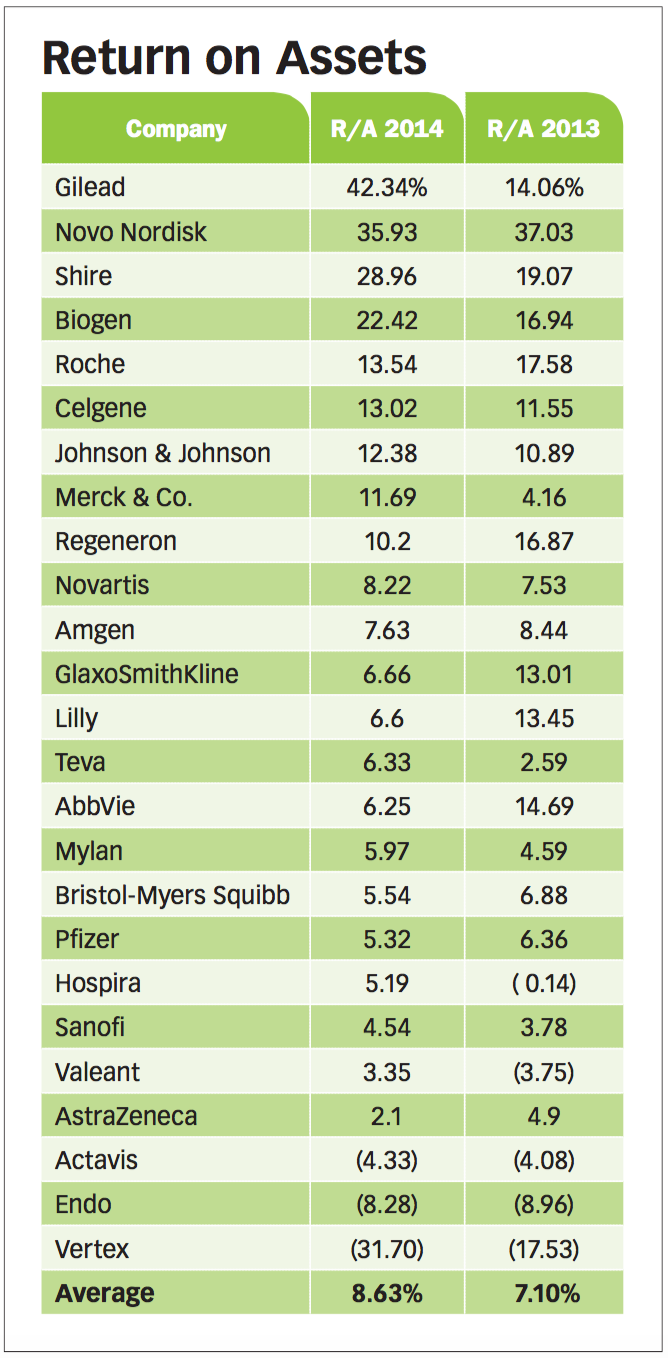
The table at left shows Gilead far ahead at the top, with a stunning metric of 42.34. To put this in perspective, the 42.34 RoA is on par with other firms’ Gross Margin. For the group as a whole, RoA increased from an average of 7.10 in 2012-2011 to 8.63 in 2014-2013. Clearly, Gilead runs a very lean operation compared to other biopharmaceutical giants, employing only 7,000 people worldwide. The key question is now that it has doubled its gross revenues in the space of less than 18 months with the success of its HCV franchise, will it loosen the purse strings and start spending and hiring at levels commensurate with a top 10 big Pharma?
Return on invested capital
Return on Invested Capital (ROIC) is a new metric we introduced in last year’s audit. Like Return on Invested Capital, it is a measure of operational excellence. There is less financial gimmickry here, just the result of how good management is at investing in and obtaining a
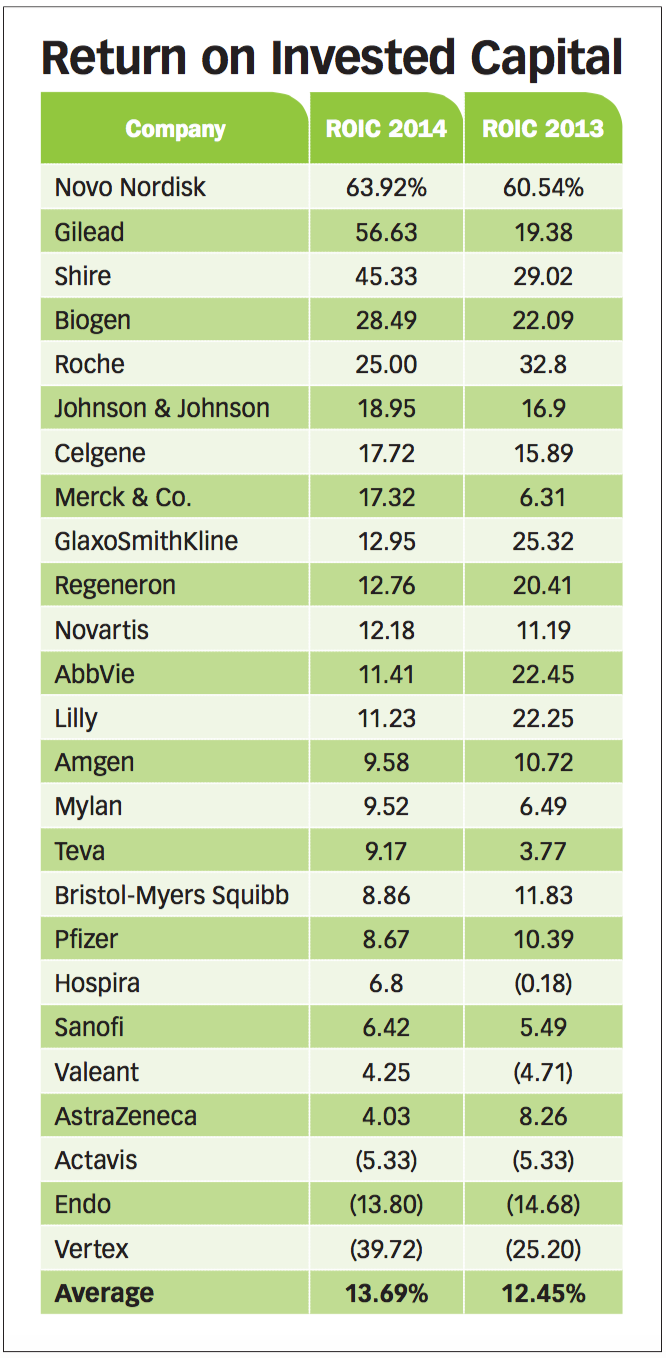
solid return on those assets. As with RoA, ROIC increased on average for our 25 firms, from 12.45 in 2012-2011 to 13.69, with Novo Nordisk again at the top, at 63.92 (see table). The bottom line? Assuming a Weighted Average Cost of Capital (WACC) of 12-15%, more than half of the firms on this year’s list are not covering their cost of capital.
Further, it is appropriate to compare ROIC and RoA, both a measure of performance, with financial engineering-like stock buybacks, option grants, and dividend handouts. These maneuvers lift earnings per share, which is then impacted by higher price to earnings multiples. The result is that rewards accrue to shareholders without the tangible benefits that come from actually investing in the business.
Net profit per employee
Net Profit per Employee (below) illustrates the profit generated per employee. A reliable measure of productivity, Gilead earns the top spot,

with each of its 7,000 employees producing $2.2 million in profit for the 2014-2013 period. This is more than three times greater than the runner-up, Novo Nordisk, far outpacing all of the big Pharma firms. One conclusion to draw from this metric is whether there is any correlation between making more money and needing more people. Gilead, with 7,000 employees, now has annual sales that exceed Lilly, yet Lilly still carries a workforce of nearly 37,000 on its books -yes, the Lilly business footprint is more diverse and complex, but can this justify the differential?
Selling, general, and administrative expenses
The table below shows yet another important metric: SG&A to Sales. But there is a caution about relying on this in assessing overall performance for shareholders. In general, SG&A growth should not exceed growth in sales, or it will start cutting into profitability. Another word for SG&A is “overhead”-when this is above average for the sector or increasing at a
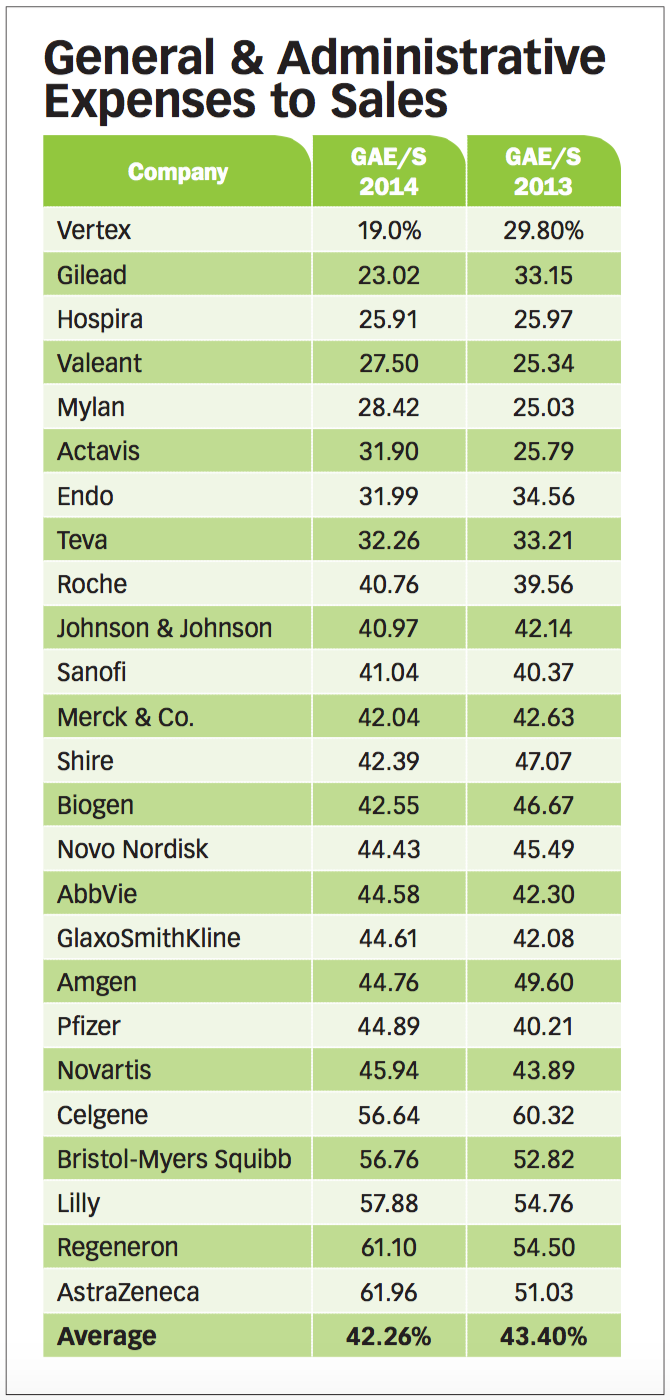
faster pace than sales, the firm can become bloated and less productive.
The reason we do not weight it is that for a given (short) time period, a company may need to pump more money into promotion, marketing, or provide money for litigation expenses, and the like. Hence, for one or two years, it is reasonable for the firm to make this kind of investment, where SG&A exceeds sales growth. As the table shows, we see that our 25 companies have achieved a slight dip in the average rate of SG&A growth, from 43.4% of sales in 2012-2011 to 42.26% in 2014-2013. AstraZeneca has the highest SG&A to Sales rate, at almost 62%, with growth in SG&A far exceeding a modest 1% rise in sales. The same can be said of Celgene and Bristol-Myers Squibb. BMS had been doing well in controlling overhead, but this year, SG&A increased faster than sales growth, which decreased from 2012-2011.
Even though we don’t weight SG&A to Sales in the rankings, it is a closely watched metric, nonetheless. The IMS Institute of Health Informatics estimates that, to maintain current levels of profitability through 2017, biopharmaceutical companies will need to reduce SG&A spending by $36 billion-not an insurmountable amount but challenging, nonetheless. The warning is reinforced by a recent McKinsey analysis of healthcare productivity. Productivity rates during the time period 1990–2007 have dropped by a negative 0.8%, even though average employment has gone up by 3%. Whatever the conclusion, this metric bears watching.
And the winner is ...
The table below reveals the top scorer-the Winner-of this year’s annual Pharmaceutical Industry Audit: Gilead. The biotech joins three other runners-up, Novo Nordisk, Biogen, and Celgene, as Pharm Exec’s collective “Four Horsemen of the Apothecary.” All four turned in exemplary numbers on the four top weighted metrics that really drive shareholder performance.
For Gilead, 2014 proved an extraordinary year; this year and next are going
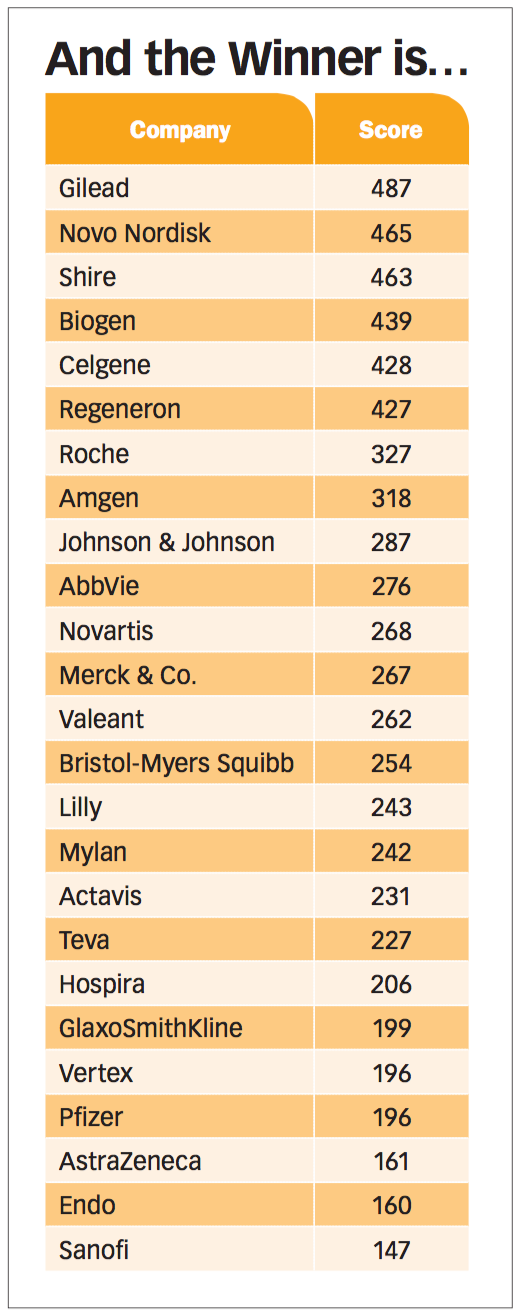
to be tougher, another indication that, while it can take years to get to the top, staying there is even harder. Notably, sales growth of over 100% due to the Sovaldi/Harvoni combination cure for HCV did not result in a corresponding growth in shareholder value.
But Gilead’s long-term prospects look better, given its increase in the Enterprise Value ([EV) to Sales ratio of 10.71 in 2014-2013, compared to 6.49 in 2012-2011, which is itself well over the average EV to Sales ratio. In addition, Gilead substantially increased its Gross Margin due to the nosebleed pricing of Sovaldi. Its profit margin, although heady, did not keep pace with the 100%-plus sales growth. Asset Management was a huge performance improvement over 2013 and far over the average for our list. Gilead’s Return on Assets was five times the list average, while the 56.63% Return on Invested Capital compares favorably to other average performers’ gross margins. Its profit per employee, in the $2 million range, is a whopping 10 times higher than the audit list average. And its SGA to Sales ratio is the second lowest of the 25 audit companies, half the average of the list.
So how good is Gilead? If you look at the numbers from Wall Street, just five firms are driving the gains in major stock indices so far this year: Amazon.com, Google, Apple, Facebook, and Gilead. Gilead is the sixth-most valuable company, in terms of market capitalization, on Nasdaq, right behind Amazon.com and ahead of Amgen, which has higher sales revenue.
Points of greatness
A common theme among the Four Horsemen is mastery of their pricing domain. All four share a Gross Margin number that is substantially higher than the list’s 68.8% average (no small feat in itself)-and their numbers here are actually higher compared to the previous year. Warren Buffet’s famous remark bears repeating. “The ability to price high is the single most important factor in evaluating the merits of a business.”
Are we looking for other attributes of superior performance? Biogen, Celgene, and Gilead placed in the top five among the Fortune 500
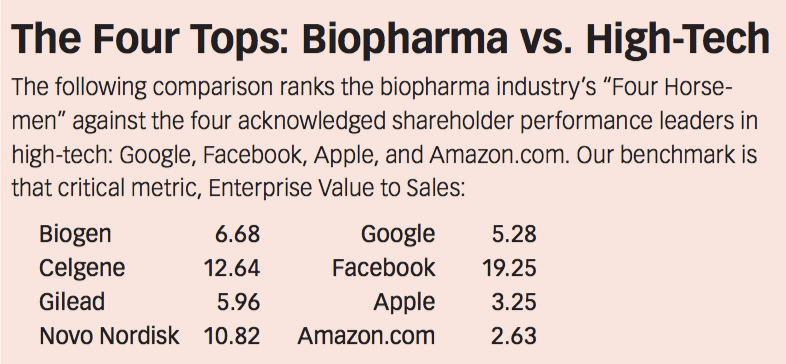
companies in percentage annual growth in earnings per share over the last 10 years. Ditto for Return to Shareholders over the same period.
Finally, for this round of Dr. Bill Trombetta’s Hall of Fame for the Best Managed Pharma Companies, the key metric, Return on Invested Capital, which has nothing to do with financial smoke and mirrors, shines on Novo Nordisk, Gilead, Shire, Biogen, J&J, Celgene, and Merck. Congratulations to the winners-despite the heady claims being made by the proponents of big data algorithms and artificial intelligence, solid management skills applied by real people do make a difference.
Behind all that focus … is operational excellence
The one thing that shareholders do expect is efficiency. Management is heeding the call-Merck stands as an example, laying off 36,000 employees over the past five years in a combined push for more productivity at lower cost in overhead. If sales are stagnant, it makes sense to work backwards on the P&L statement and balance sheet to improve profit. J&J has also improved significantly on key metrics of Return on Assets and Return on Invested Capital. Although Valeant’s SG&A increased this year, it rose at a slower pace and, thus, did not derail its solid performance on Gross Margin. There are many ways to skin the cat in pursuit of shareholder value, but prudent use of your owner’s money is the best way to start.
Bill Trombetta, PhD, is a Professor of Pharmaceutical and Healthcare Marketing at St. Joseph’s University, Haub School of Business. He can be reached at dtrombet@aol.com.
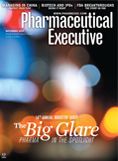
Cell and Gene Therapy Check-in 2024
January 18th 2024Fran Gregory, VP of Emerging Therapies, Cardinal Health discusses her career, how both CAR-T therapies and personalization have been gaining momentum and what kind of progress we expect to see from them, some of the biggest hurdles facing their section of the industry, the importance of patient advocacy and so much more.